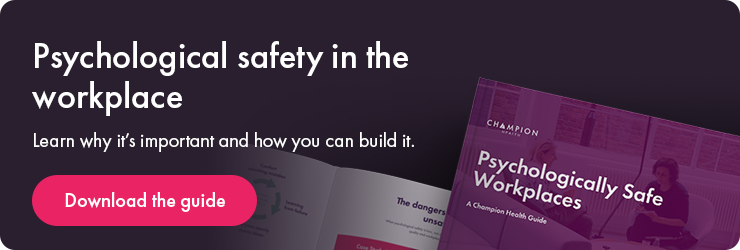A study on team performance by Google found that the highest-performing teams have one thing in common: psychologically safe workplaces. But what is psychological safety at work, and how do you build it?
It doesn’t matter what your organisation does, how it operates, or whether your workforce is remote or office-based; psychological safety at work is a must-have.
Psychologically safe workplaces promote healthier, more productive and more inclusive workforces. They also provide the environment in which innovation can thrive and people can perform at their best.
That’s why, as organisations navigate new and ever-increasing challenges, the need for psychological safety at work is only growing, and interest in how to develop this culture is increasing.
In this article, we’re going to look at all things psychological safety: what it is, what it is not, why it’s important and how can you build it.
We’ll also answer some of the more commonly asked questions surrounding psychological safety in the workplace.
Looking for a downloadable guide with all of this information? Discover that here: Psychologically Safe Workplaces.
What is psychological safety?
Psychological safety describes an environment where people feel able to express themselves without fear that others will think less of them.
In the workplace, that translates to employees feeling comfortable speaking up, whether they’re sharing ideas, asking questions, expressing concerns or acknowledging mistakes.
This creates an environment where people feel comfortable being themselves and develops a climate that is characterised by interpersonal trust and mutual respect.
Find out more about psychological safety and how it can benefit your teams in this short video from Laura Dallas, Head of Product at Champion Health.
What psychological safety is not (myths)
Psychological safety is often misunderstood, so let’s debunk 3 of the most commonplace myths surrounding it.
1. “Psychological safety is about everyone agreeing on everything all the time”
On the contrary, healthy conflict is a vital component of a psychologically safe environment. People should feel comfortable disagreeing with each other and know how to express this in a healthy way.
2. “In a psychologically safe environment, laziness, complacency and incompetence are accepted”
Psychologically safe does not mean “anything goes.” There’s still room for effective discipline. However, when employees are happy and invested, they are far less likely to lose interest and work ineffectively.
3. “Psychological safety is not beneficial in high-pressure environments”
To coin the term, Harvard professor Amy Edmondson developed her research in the medical and aviation industries. Even in these critical environments, the best-performing teams showed high levels of psychological safety.
Why psychological safety is important
Psychological safety is important because it creates an environment where people can bring their full contributions to work, every day. It gives every employee an equal opportunity to thrive, regardless of their situation.
A psychologically safe environment will also allow creativity and innovation to flourish. Your employees will be more open-minded, creative, and able to find solutions.
And when things do go wrong, they can be dealt with far more efficiently and effectively in a psychologically safe environment.
When people are comfortable admitting mistakes, then issues within the workplace can be spotted early and resolved quickly, before they become a significant problem.
Finally, psychological safety has been proven to reduce staff turnover, a huge pain point for any organisation. According to the People Management Report, employees who feel psychologically safe in their team are less likely to quit their jobs.
How to measure psychological safety
The following questions make up the Fearless Organisation Scan: a framework you can use to measure the psychological safety within your team or organisation.
By answering these questions honestly, you’ll can give yourself a good idea of the level of psychological safety within your team.
- If someone makes a mistake on your team, is it often held against them?
- Are members of your team able to bring up problems and tough issues?
- Do people on your team sometimes reject others for being different?
- Is it safe to take a risk on your team?
- Is it difficult for members of your team to ask other members for help?
- Does anyone on your team deliberately act in a way that undermines another’s efforts.
- Are the unique skills and talents of people on your team valued and utilised?
How to create psychologically safe workplaces
The following 10 tips will help you build psychological safety within your workplace.
- Model Curiosity
- Acknowledge your own fallibility
- Give constructive feedback
- Make sure you’re available and make sure your team knows it
- Invite feedback
- Get comfortable with failure
- Put a ban on blame
- Welcome curiosity
- Praise effort, not just results
- Hold regular ‘town hall’ meetings
Read on for a more detailed look at each of the steps you can take to build psychological safety at work.
1. Model curiosity: Start conversations, encourage debate and ask your employees lots of questions. Doing these things encourages your workforce to speak up and promotes healthy discussion within the workplace.
2. Acknowledge your own fallibility: If employees see their seniors admitting to their shortcomings, and showing a thirst to learn, they are more likely to do so themselves. Phrases like “I may miss things – I need your input” are great for this.
3. Give constructive feedback: It’s vital that your employees do not feel criticised or stilted by your feedback. When giving feedback, try to draw on an individuals’ strengths whilst encouraging growth in areas requiring improvement.
4. Make sure you’re available and make sure your team knows it: An open-door policy is pointless if no-one comes to the door. Make sure your team know that you are there to help. When they do approach you, try to be approachable, open-minded and non-judgmental.
5. Invite feedback: Being open to feedback shows your team that you’re confident in your ability, but also flexible in your approach and open to change.
6. Get comfortable with failure: Fear of making mistakes can stifle creativity and independent thinking, so it’s vital that your workforce know that it’s okay to make errors. Reframe these mistakes as an opportunity for team learning.
7. Put a ban on blame: When something goes wrong, instead of singling someone out for blame, talk about how the team can work together to put it right.
8. Welcome curiosity: Encourage your employees to voice their opinion, ask questions and challenge decisions. Every breakthrough is the result of curiosity, so it’s also good practice to promote healthy debate around decisions that are made.
9. Praise effort, not just results: If your workforce believe that performance is contingent on effort, and not just results, they are willing to try new things and persevere in the face of failure.
10. Hold regular ‘town hall’ meetings: Hold regularly scheduled meetings, where any member of the organisation can pose ideas or questions to upper management.
When people do speak up, makes sure they know that their ideas or suggestions are being taken seriously.
Discover more ways to build psychological safety at work by watching this exclusive Champion Health live session.
How does psychological safety actually work?
Psychological safety is about culture more than anything. By following some of the steps we’ve discussed, you can build a culture within your workforce where people will speak up, without feeling like others will think less of them if they do so.
Your employees will also feel more comfortable talking about mental health and discussing any struggles they’re having.
If you manage to successfully create this culture, then you will have taken significant steps towards achieving psychological safety at work.
How does psychological safety contribute to creativity
Essential to creativity and innovation is the willingness of your employees to take risks. In a psychologically safe environment, your team will feel able to take risks, without fear of mistakes.
They will also feel comfortable raising ideas, no matter how novel they might seem. When this happens, innovation and creativity thrive.
Who coined the term psychological safety?
Psychological safety was first explored by organisational scholars in the 1960s, but it was Professor Amy Edmondson who coined the term in 1999, following her research into the concept of psychological safety within work teams.
The term gained greater prominence in 2015 with the publication of Project Aristotle, the study by Google which found that psychological safety was the most important factor in successful teams.
Is psychological safety the same as trust?
Psychological safety is not the same as trust, but trust is a vital part in psychological safety. To build psychological safety within a team, both team members and team leaders need to demonstrate to each other that they can be trusted.
Not just a “nice-to-have”
Psychological safety is not a nice-to-have. It’s actually a pre-requisite to any high-performing organisation. Developing psychological safety within your team takes off the brakes that keep people from achieving what is possible.
In doing so, you can develop a fearless organisation, where your people feel trusted and respected, where innovation and creativity thrive, and where everybody has the opportunity to perform to their potential.






